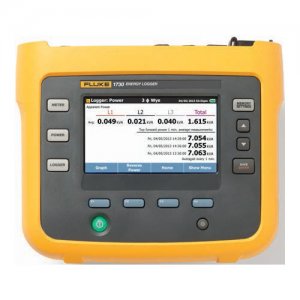You have 0 items in your cart.
The Fluke 1730 Three-Phase Electrical Energy logger introduces a new simplicity to discovering sources of electrical energy waste. Discover when and where energy in your facility is being consumed; from the service entrance to individual circuits. Profiling energy usage across your facility helps you identify opportunities for energy savings, and provides you with the data you need to act on them. The Fluke 1730 Energy Analyzer software package allows you to compare multiple data points over time to build a complete picture of energy usage, which is the first step to reduce the cost of your energy bill.
Load studies Discover how much energy individual pieces of equipment are consuming when they are operating at minimum and maximum capacity. Check capacity of circuits prior to adding additional loads (various standards exist for this process; in the US the NEC 220-87 is the recommended standard). Load studies can also identify situations where you may be exceeding the allowable load on the circuit or when an agreed peak demand applies from the utility. For convenience, some load studies simply measure current which makes installation of the measuring equipment quick and easy. It is often recommended that load surveys be performed for 30 days so that all typical load conditions are encountered during the test.
Energy surveys
Users often ask where measurements should be taken for an energy survey. The answer is multiple points within the facility. Start at the main service feeders; compare the power and energy measured here with the readings from the utility meter to ensure you’re receiving the correct charges. Then move downstream to the larger loads; these should be easy to identify by the current rating of the electrical panels downstream of the service entrances. Measuring at many points will allow a full picture of energy usage across the facility to be developed. The next question users typically have is how long an energy survey should last. This of course depends on the facility, but it is recommended that you measure for a period that matches a typical facility activity period. If the facility operates over a five day work week with down time on the weekend, a seven day survey will most likely capture typical conditions. If the facility operates at a constant level for 24 hours a day, 365 days a year, a single day could be reasonably representative as long as you avoid a period where there may be planned maintenance.
To capture a full picture of the facilities energy usage it is not necessarily required to have measurements made with the Fluke 1730 simultaneously at every consumption point in the facility. To get a comprehensive picture, spot measurements can be made and then compared on a sliding time timescale. For example, you could compare the service entrance results from a typical Tuesday between 6:00 am and 12:00 pm with those of a larger load in the facility. Typically there will be some correlation between these profiles.
Power and energy logging
When a piece of equipment is operated it instantaneously consumes a specific amount of power in watts (W) or kilowatts (kW). This power is accumulated over the operating time and expressed as energy consumed in kilowatt hours (kWh). Energy is what your electric utility charges for; there will be a standard charge from the utility per kilowatt hour. Utilities may have other additional charges, such as peak demand, which is the maximum power demand over a defined period of time, often 15 or 30 minutes. There may also be power factor charges, which are based on the effects of the inductive or capacitive loads in the facility. Optimizing peak demand and power factor often results in lower monthly electricity bills. The Fluke 1730 Three Phase Electrical Energy logger has the capability to measure and characterize these effects enabling you to analyze the results and save money.
Simplified load studies
For situations where it’s either difficult or impractical to make a voltage connection the simple load study feature allows users to perform a simplified load study by measuring current only. The user can enter the nominal expected voltage to create a simulated power study. For accurate power and energy studies it is required to monitor both voltage and current but this simplified method is useful in certain circumstances.





